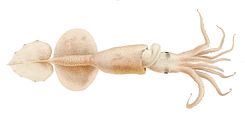Paralarva


Paralarvae (sg.: paralarva) are young
Teuthida.[2]
The term was first introduced by Richard E. Young and Robert F. Harman in 1988.[2]
Paralarvae usually spend an uncertain amount of time in the plankton and then typically descend to an adult habitat in the mesopelagic or bathypelagic zone. Their population abundance is dependent on the variation of mortality rates during the planktonic period.
tentacular clubs bear approximately 20 irregularly arranged suckers. Two chromatophores are present on each side of the mantle. Centre: Ventral, dorsal and side views of a more advanced paralarva. An equatorial circulet of seven large yellow-brown chromatophores is present on the mantle. Posteriorly the expanded vanes of the gladius
are visible in the dorsal view. Right: Ventral and dorsal views of a very advanced paralarva.See also
- Larva
- Crustacean larvae
References
- ^ "Paralarvae". Larval Images: Larval forms diverse and beautiful!. Archived from the original on 2018-08-16.
- ^ a b Richard Edward Young & Robert F. Harman (1988). ""Larva", "Paralarva", and "Subadult" in Cephalopod Terminology". Malacologia. 29 (1): 201–207. Retrieved August 13, 2011.
Further reading
- Bigelow, Keith A. "Age and growth in paralarvae of the mesopelagic squid Abralia trigonura based on daily growth increments in statoliths." Marine ecology progress series. Oldendorf 82.1 (1992): 31–40.




